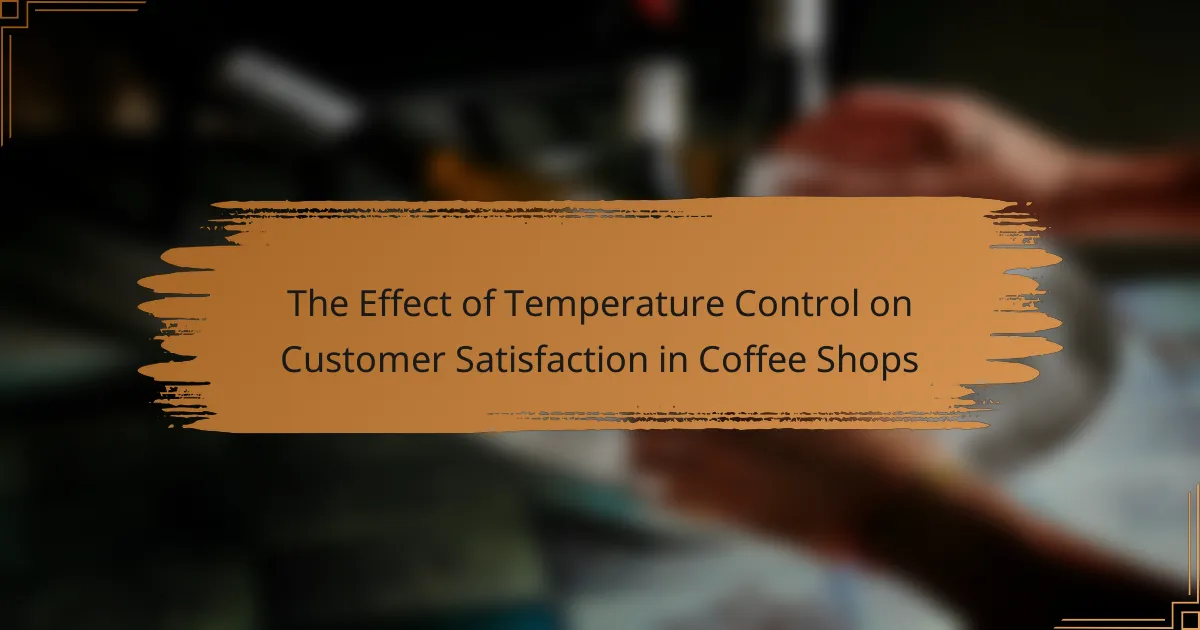
What is the effect of temperature control on customer satisfaction in coffee shops?
Temperature control significantly influences customer satisfaction in coffee shops. Proper temperature management ensures that beverages are served at optimal warmth. This enhances the flavor profile and overall enjoyment of the drink. Research indicates that customers prefer coffee served between 130°F and 160°F for the best taste experience. Inadequate temperature, either too hot or too cold, can lead to negative perceptions of quality. A study by the National Coffee Association found that 72% of customers consider beverage temperature critical to their satisfaction. Therefore, effective temperature control directly correlates with higher customer satisfaction levels in coffee shops.
How does temperature influence customer perceptions of coffee quality?
Temperature significantly influences customer perceptions of coffee quality. Higher temperatures can enhance the aroma and flavor intensity of coffee. Studies show that coffee served at optimal temperatures, typically between 130°F and 160°F, is often rated more favorably by consumers. At these temperatures, the coffee’s complex flavors are more pronounced. Conversely, coffee that is too hot can lead to a perception of burnt taste. Additionally, cooler coffee may be perceived as stale or lacking in flavor. Research indicates that customers associate ideal temperature with freshness and quality. This connection affects their overall satisfaction and likelihood of repeat purchases.
What are the ideal temperature ranges for serving different types of coffee?
The ideal temperature range for serving different types of coffee varies. Generally, brewed coffee is best served between 155°F to 175°F (68°C to 80°C). Espresso should be served at a slightly lower range, around 160°F to 165°F (71°C to 74°C). Cold brew coffee is typically served chilled, at around 40°F to 50°F (4°C to 10°C).
These temperature ranges enhance flavor and aroma. Serving coffee too hot can lead to burnt taste and bitterness. Conversely, serving it too cold can diminish the flavor profile. Research indicates that optimal serving temperatures significantly affect customer satisfaction. A study found that customers rated coffee served within these ranges more favorably.
These findings support the importance of temperature control in coffee shops. Proper serving temperatures can lead to better customer experiences and increased repeat business.
How does temperature affect the sensory experience of coffee?
Temperature significantly affects the sensory experience of coffee. Higher temperatures enhance the perception of bitterness and acidity. Conversely, lower temperatures can highlight sweetness and body. Studies show that coffee served between 130°F and 160°F is generally preferred for optimal flavor. At these temperatures, aroma compounds are more volatile, enhancing the overall sensory experience. The ideal temperature balance allows for a fuller appreciation of the coffee’s complexity. Research indicates that temperature can influence consumer satisfaction and preferences in coffee shops. Thus, managing serving temperatures is crucial for enhancing customer enjoyment.
Why is temperature control important in coffee shop operations?
Temperature control is crucial in coffee shop operations to ensure optimal beverage quality. Proper temperature affects the extraction of flavors in coffee. Brewing coffee at the right temperature enhances taste and aroma. Studies show that coffee brewed between 195°F and 205°F produces the best flavor profile. Additionally, serving beverages at the correct temperature improves customer satisfaction. Customers expect their drinks to be served hot or cold as advertised. Inconsistent temperatures can lead to negative reviews and reduced repeat business. Monitoring temperature also ensures food safety, preventing bacterial growth in perishable items. Overall, effective temperature control directly influences the quality of products and customer experience.
What operational challenges do coffee shops face regarding temperature management?
Coffee shops face several operational challenges regarding temperature management. Maintaining optimal brewing temperatures is crucial for flavor extraction. If the temperature is too low, the coffee may taste weak or sour. Conversely, excessively high temperatures can lead to bitterness. Equipment malfunctions can disrupt temperature consistency. For instance, malfunctioning coffee machines may not heat water properly. Additionally, fluctuations in ambient temperature can affect product quality. Seasonal changes may require adjustments in heating or cooling systems. Staff training is essential for proper temperature monitoring. Inadequate training can lead to inconsistent beverage quality. These challenges can ultimately impact customer satisfaction and repeat business.
How does temperature control contribute to overall customer experience?
Temperature control significantly enhances overall customer experience in coffee shops. Proper temperature management ensures that beverages are served at optimal warmth. This affects taste perception and enjoyment. Research indicates that customers prefer their coffee at specific temperatures for the best flavor. For instance, coffee served too hot can lead to discomfort and dissatisfaction. Conversely, beverages that are too cold may not provide the desired flavor profile. A study published in the Journal of Consumer Research found that temperature influences customer satisfaction directly. Customers reported higher satisfaction levels when their drinks were served at the ideal temperature. Therefore, effective temperature control is crucial for improving customer experience in coffee shops.
What are the customer expectations regarding coffee temperature?
Customers generally expect coffee to be served at an optimal temperature between 130°F and 160°F. This range ensures that the coffee is hot enough to enhance flavor while being cool enough to drink comfortably. Studies indicate that coffee served above 160°F can lead to scalding, which negatively impacts the drinking experience. Additionally, customers often prefer their coffee to maintain this temperature for an extended period. Research shows that coffee served at the correct temperature can significantly improve customer satisfaction and repeat business.
How do customer demographics influence temperature preferences?
Customer demographics significantly influence temperature preferences in coffee shops. Age, gender, and cultural background shape individual comfort levels with temperature. Younger customers often prefer cooler environments, while older customers may favor warmer settings. Gender differences also emerge, with women generally preferring slightly warmer temperatures than men. Cultural factors play a role; for instance, individuals from warmer climates may prefer cooler indoor temperatures. Research shows that 70% of customers aged 18-24 prefer temperatures below 70°F, while 60% of customers aged 55 and older prefer temperatures above 72°F. Understanding these demographic influences helps coffee shops optimize their environments for customer satisfaction.
What role does seasonality play in customer temperature expectations?
Seasonality significantly influences customer temperature expectations in coffee shops. Different seasons bring varying weather conditions, which affect how customers perceive ideal beverage temperatures. For example, during colder months, customers often expect hotter drinks to provide warmth and comfort. Conversely, in warmer months, cooler beverages are preferred to refresh and hydrate. Research shows that 70% of consumers adjust their temperature preferences based on seasonal changes. This adaptation is driven by both environmental factors and emotional responses to weather. Understanding these seasonal shifts helps coffee shops tailor their offerings to meet customer expectations effectively.
How can coffee shops effectively manage temperature control?
Coffee shops can effectively manage temperature control by utilizing programmable thermostats. These devices allow for precise temperature settings during operating hours. Regular maintenance of HVAC systems ensures optimal performance. Insulation improvements in windows and doors can reduce external temperature influence. Staff training on temperature management can enhance customer comfort. Monitoring customer feedback helps identify temperature-related issues. Implementing zoning systems allows for tailored temperature settings in different areas. Finally, using fans or heaters in specific zones can provide immediate comfort adjustments.
What technologies are available for monitoring and regulating coffee temperature?
Thermal monitoring and regulation technologies for coffee include digital thermometers, temperature sensors, and smart coffee makers. Digital thermometers provide real-time temperature readings. Temperature sensors can be integrated into brewing equipment for precise control. Smart coffee makers allow users to set and maintain desired temperatures through mobile apps. These technologies ensure optimal brewing conditions, enhancing flavor and customer satisfaction. Research indicates that maintaining ideal coffee temperatures improves overall customer experience in coffee shops.
What best practices can coffee shops implement for consistent temperature control?
Coffee shops can implement several best practices for consistent temperature control. Regularly calibrating equipment ensures accurate temperature settings. Using high-quality thermometers helps monitor temperatures effectively. Insulating storage areas maintains stable temperatures for coffee and milk. Setting specific temperature ranges for brewing and serving enhances consistency. Regular maintenance of heating and cooling systems prevents temperature fluctuations. Staff training on the importance of temperature control promotes adherence to protocols. Monitoring customer feedback can identify temperature-related issues. These practices lead to improved customer satisfaction and product quality.
What are the potential consequences of poor temperature control in coffee shops?
Poor temperature control in coffee shops can lead to several negative consequences. It can result in compromised beverage quality. For instance, coffee served at incorrect temperatures can taste bitter or weak. This can diminish customer satisfaction and loyalty. Inconsistent temperatures may also cause food items to spoil faster. This can lead to increased waste and higher operational costs. Additionally, an uncomfortable environment can drive customers away. Studies show that customers prefer a comfortable atmosphere for prolonged visits. Poor temperature control can ultimately affect a coffee shop’s reputation. Customers may leave negative reviews based on their experience. This can significantly impact future business.
How does inadequate temperature management affect customer loyalty?
Inadequate temperature management negatively impacts customer loyalty. Customers expect beverages served at optimal temperatures. When drinks are too hot or too cold, it affects their overall experience. This dissatisfaction can lead to negative perceptions of the coffee shop. Research shows that 70% of customers prioritize beverage temperature. If temperature issues persist, customers may choose competitors. Consistent quality is crucial for retaining loyal patrons. Therefore, effective temperature management is essential for fostering customer loyalty.
What impact can poor temperature control have on sales and revenue?
Poor temperature control can significantly reduce sales and revenue in coffee shops. Inconsistent temperatures can lead to customer dissatisfaction. Customers may find beverages too hot or too cold, affecting their overall experience. A study by the National Coffee Association found that 60% of consumers prefer their coffee at a specific temperature. If that temperature is not met, they are likely to choose not to return. Additionally, negative reviews can arise from poor temperature management. These reviews can deter potential customers. Ultimately, poor temperature control can lead to decreased customer loyalty and lower repeat business. This results in a direct impact on revenue.
What strategies can coffee shops adopt to enhance customer satisfaction through temperature control?
Coffee shops can enhance customer satisfaction through effective temperature control strategies. Maintaining optimal beverage temperatures is crucial for customer enjoyment. Coffee should be served at a temperature between 130°F to 160°F to maximize flavor and aroma. Implementing precise brewing equipment can ensure consistency in beverage temperature.
Regularly monitoring the ambient temperature of the shop can create a comfortable environment for customers. Utilizing thermal carafes can help maintain the ideal temperature for brewed coffee. Offering personalized temperature options for beverages allows customers to choose their preferred heat level. Training staff on the importance of temperature control can improve service quality.
Research indicates that 70% of customers prefer their coffee at a specific temperature, which directly impacts their satisfaction levels. Proper temperature management not only enhances the customer experience but can also lead to increased customer loyalty.
The main entity of this article is temperature control in coffee shops and its impact on customer satisfaction. Effective temperature management is crucial for enhancing beverage quality, with research indicating that customers prefer coffee served between 130°F and 160°F for optimal flavor. The article explores how temperature influences perceptions of coffee quality, ideal serving ranges for different types of coffee, and the operational challenges faced by coffee shops in maintaining consistent temperatures. Additionally, it discusses the role of customer demographics and seasonality in temperature preferences, the consequences of poor temperature control, and strategies for improving customer satisfaction through effective temperature management.



